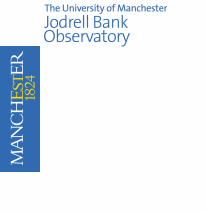MSc Projects 2005
Pulsars provide the nearest thing to a physicist's dream come true. Being the end-point of stellar evolution, they are densest bodies next to black holes and give us an insight into the most extreme physical conditions of matter density, pressure and magnetic field observable by man. They also provide the most precise clocks known to humankind for undertaking unique experiments of gravitation and general relativity. Furthermore, they can be used as probes of the distribution of ionised material and magnetic field in the Galaxy with a precision which nothing else can. We use the telescopes at Jodrell Bank, Parkes (Australia) and Arecibo (Puerto Rico) in this work and frequently travel to the foreign instruments to make observations. The pulsar group at Jodrell Bank are arguably the most productive in the world in this area and have discovered more than three-quarters of the known population of these elusive and fascinating objects.
There are several main active areas of research in the general area of pulsar astronomy which would support projects which would be ideal for students, starting in September 2005. We outline some of these below. Portions of a further three projects listed on the PhD page may also be suitable for MSc students. Links to these projects can be found at the bottom of this page.
Modelling the Binary Pulsar Population in our Galaxy
Understanding how pulsars are born, evolve and ultimately end their lives is a fascinating subject which utilises a number of areas of astrophysics: stellar structure and evolution, orbital mechanics and binary evolution, neutron star kinematics, accretion physics etc. Since over half of all normal stars are in binary systems, the evolution of binary stars plays a key role in understanding the different types of pulsars we observe. A simplified version of the various channels of binary pulsar evolution is shown in the cartoon below.
The aim of this project is to develop a Monte Carlo simulation to follow in detail the above evolutionary paths and predict the various fractions of pulsar populations that we observe. The basis for this work will, initially be the comprehensive framework described in this paper and the first task will be to reproduce the results of this work. With this simulation in hand, the student will be able to explore the various impacts that initial conditions have on the resulting simulated populations. The second part of the project will be to extend this model to take account of known observational selection effects which bias the underlying sample in order to make testable predictions on the number of binary systems we observe. A student, preferably competent in C programming, is sought to take up this project which will serve as an excellent introduction to Monte Carlo simulations, population modelling and statistical/numerical techniques. For further information, please contact Dunc Lorimer (drl@jb.man.ac.uk)
Probing the Interstellar Medium using Pulsars
This project is described in full here. Part of this project could be tackled as a self-contained MSc thesis. Please contact Michael Kramer (mkramer@jb.man.ac.uk) or Maura McLaughlin (mclaughl@jb.man.ac.uk) for details.
